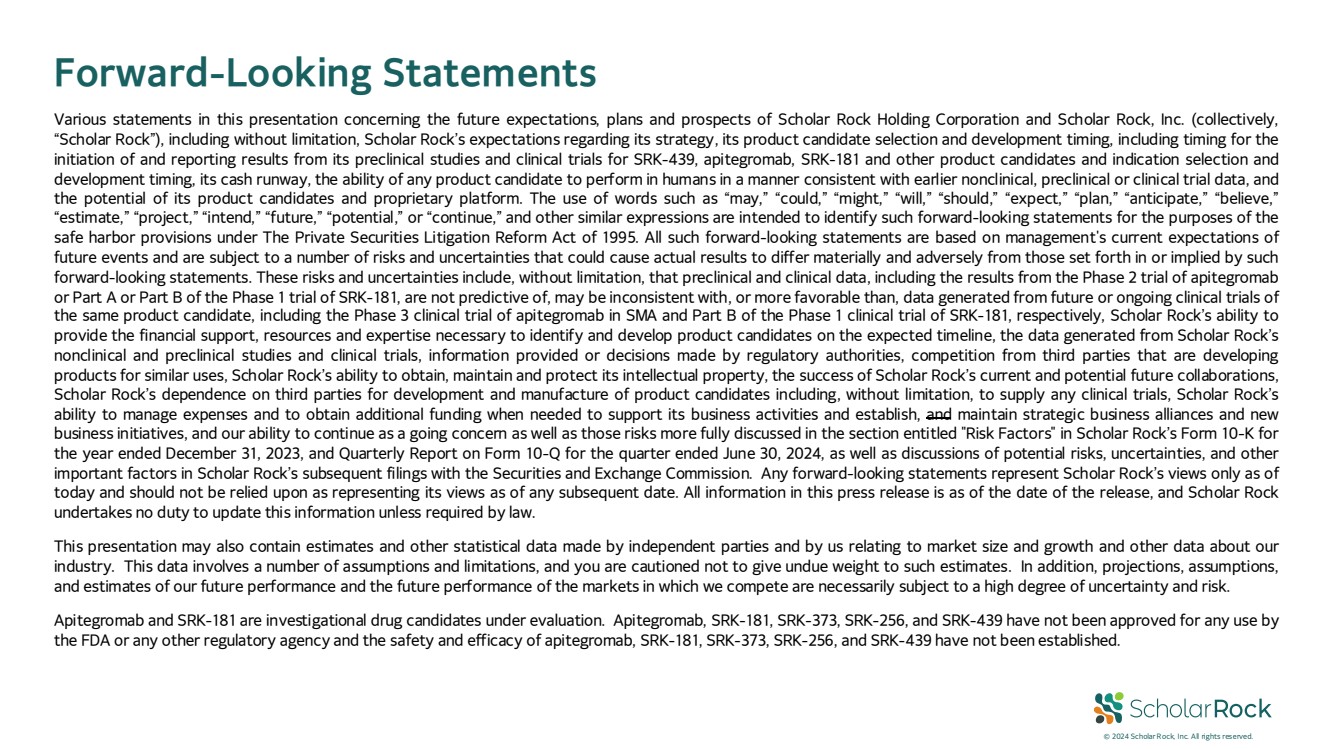
| © 2024 Scholar Rock, Inc. All rights reserved.
Forward-Looking Statements
Various statements in this presentation concerning the future expectations, plans and prospects of Scholar Rock Holding Corporation and Scholar Rock, Inc. (collectively,
“Scholar Rock”), including without limitation, Scholar Rock’s expectations regarding its strategy, its product candidate selection and development timing, including timing for the
initiation of and reporting results from its preclinical studies and clinical trials for SRK-439, apitegromab, SRK-181 and other product candidates and indication selection and
development timing, its cash runway, the ability of any product candidate to perform in humans in a manner consistent with earlier nonclinical, preclinical or clinical trial data, and
the potential of its product candidates and proprietary platform. The use of words such as “may,” “could,” “might,” “will,” “should,” “expect,” “plan,” “anticipate,” “believe,”
“estimate,” “project,” “intend,” “future,” “potential,” or “continue,” and other similar expressions are intended to identify such forward-looking statements for the purposes of the
safe harbor provisions under The Private Securities Litigation Reform Act of 1995. All such forward-looking statements are based on management's current expectations of
future events and are subject to a number of risks and uncertainties that could cause actual results to differ materially and adversely from those set forth in or implied by such
forward-looking statements. These risks and uncertainties include, without limitation, that preclinical and clinical data, including the results from the Phase 2 trial of apitegromab
or Part A or Part B of the Phase 1 trial of SRK-181, are not predictive of, may be inconsistent with, or more favorable than, data generated from future or ongoing clinical trials of
the same product candidate, including the Phase 3 clinical trial of apitegromab in SMA and Part B of the Phase 1 clinical trial of SRK-181, respectively, Scholar Rock’s ability to
provide the financial support, resources and expertise necessary to identify and develop product candidates on the expected timeline, the data generated from Scholar Rock’s
nonclinical and preclinical studies and clinical trials, information provided or decisions made by regulatory authorities, competition from third parties that are developing
products for similar uses, Scholar Rock’s ability to obtain, maintain and protect its intellectual property, the success of Scholar Rock’s current and potential future collaborations,
Scholar Rock’s dependence on third parties for development and manufacture of product candidates including, without limitation, to supply any clinical trials, Scholar Rock’s
ability to manage expenses and to obtain additional funding when needed to support its business activities and establish, and maintain strategic business alliances and new
business initiatives, and our ability to continue as a going concern as well as those risks more fully discussed in the section entitled "Risk Factors" in Scholar Rock’s Form 10-K for
the year ended December 31, 2023, and Quarterly Report on Form 10-Q for the quarter ended June 30, 2024, as well as discussions of potential risks, uncertainties, and other
important factors in Scholar Rock’s subsequent filings with the Securities and Exchange Commission. Any forward-looking statements represent Scholar Rock’s views only as of
today and should not be relied upon as representing its views as of any subsequent date. All information in this press release is as of the date of the release, and Scholar Rock
undertakes no duty to update this information unless required by law.
This presentation may also contain estimates and other statistical data made by independent parties and by us relating to market size and growth and other data about our
industry. This data involves a number of assumptions and limitations, and you are cautioned not to give undue weight to such estimates. In addition, projections, assumptions,
and estimates of our future performance and the future performance of the markets in which we compete are necessarily subject to a high degree of uncertainty and risk.
Apitegromab and SRK-181 are investigational drug candidates under evaluation. Apitegromab, SRK-181, SRK-373, SRK-256, and SRK-439 have not been approved for any use by
the FDA or any other regulatory agency and the safety and efficacy of apitegromab, SRK-181, SRK-373, SRK-256, and SRK-439 have not been established. |